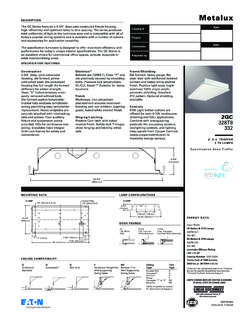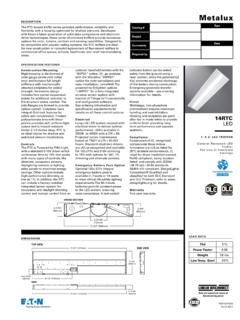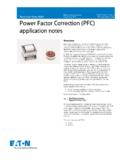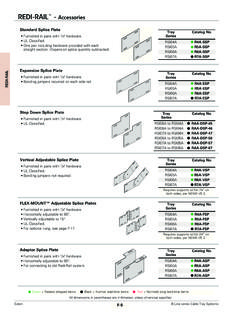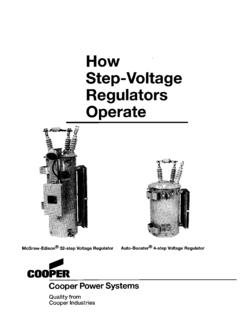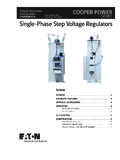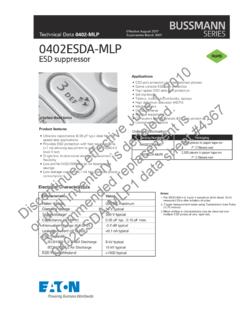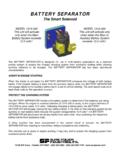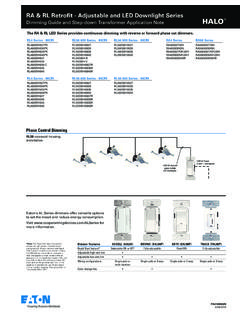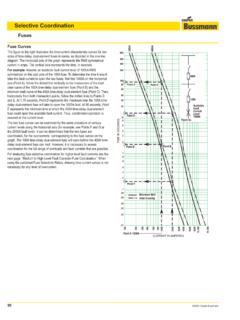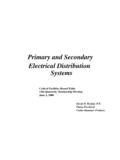Transcription of Bussmann Code Changes Based on the 2014 NEC # 10323
1 2014 NEC code ChangesCode Changes Based on the 2014 NEC 22014 NEC code changesWhat you ll find in this handbook ..3 Interrupting rating Article 110 Requirement for electrical installations Part I general ..4-5 Available fault current (A) Field marking Article 110 Requirement for electrical installations Part I general ..6-7 Definition of coordination, selective Article 100 Definitions Part I general .. , , and Selective coordination Article 700 Emergency Systems, part VI overcurrent protection; article 701 Legally Required Standby Systems, part IV overcurrent protection; and Critical Operations Power Systems Part IV overcurrent protection .. Selective coordination Article 620 elevators, dumbwaiters, escalators, moving walks, platform lifts, and stairway chairlifts Part VII overcurrent protection .. Selective coordination Article 645 Information technology equipment.
2 (G) Coordination Article 517 Healthcare facilities Part III essential systems .. (B)(1)(1) Exception and (C)(2)(1) Exception Concerning 10 foot tap rule Article 240 Overcurrent protection Part II location .. Surge protection Article 700 Emergency systems Part I general .. Type 4 and other component type SPDs Article 285 Surge Protective Devices (SPDs), 1000V or less Part II installation ..24-25 Location of overcurrent protection Article 705 Interconnected electric power production sources Part I general ..26-27 Table of contentsInterrupting ratingSelective coordinationCoordinationOverviewSurge protectionLocation of overcurrent protectionMarking fault current32014 NEC code changesOverviewOverviewWhat you ll find in this handbookThis brochure highlights the 2014 NEC Changes pertaining to circuit protection. Please refer to the Selecting Protective Devices (SPD) handbook No.
3 3002, Based on the 2014 NEC for more detail and further NEC code Interrupting RatingArticle 110 Requirements for Electrical Installations Par t I Interrupting Rating. Equipment intended to interrupt current at fault levels shall have an interrupting rating not less than the at nominal circuit voltage and sufficient for the current that is available at the line terminals of the equipment. Equipment intended to interrupt current at other than fault levels shall have an interrupting rating at nominal circuit voltage not less than sufficient for the current that must be of the change is located in Article 110 , Chapter 1 General Requirements, which applies generally to all electrical installations. This is a safety requirement that if not met, can result in catastrophic, explosive failure to an overcurrent protective device, switch, or controller. The remainder of this discussion will focus on fault current interrupting a fuse or circuit breaker voltage rating and ampere rating are selected, Based upon the application and requirements in other Articles of the NEC , the selection process is not complete.
4 The first sentence of requires that a fuse or circuit breaker must additionally have an interrupting rating at the system voltage sufficient for the available fault current at the line terminals of the fuse or circuit breaker. There are two means for compliance with The first is fully rated fuses and circuit breakers which means that each fuse or circuit breaker has an individual interrupting rating at the applied voltage which is equal to or greater than the available fault current at the line terminals of the fuse or circuit breaker ( ). The second method is to comply with series ratings. In this case, a circuit breaker can be applied where the available fault current exceeds the circuit breaker s interrupting rating for the applied voltage, if an upstream fuse or circuit breaker provides the level of protection for the downstream circuit breaker in compliance with and equipment labeling is per and In order to comply with the fault current interrupting rating requirement, it typically is necessary to calculate the available fault current at each location where a fuse or circuit breaker is to be applied.
5 Then a fuse or circuit breaker must be selected where the interrupting rating is sufficient at the applied voltage. Related NEC Sections Article 100 Definitions: Interrupting see page (C) (C) Editorial change for clarity and consistency between first sentence which pertains to fault current interrupting rating for overcurrent protective devices and the secondChange summaryM M X1 X3 X2 X4 X5 X6 X7 25kAIR10kAIR10kAIR300kAIR300kAIR300kAIR2 5kAIR300kAIR300kAIR10kAIR10kAIR14kAIR14k AIR22kAIR48,250A24,740A12,050A36,120A8,1 60A38,200 AThese CBs have100 kA seriescombinationrating with these fusesWhich circuit breakers or fuses have an inadequate interrupting rating?sentence which pertains to devices that interrupt other than fault current, such as switches and motor NEC code FC2 Available Fault Current Calculator: downloadable App and on-line Selecting Protective Devices publication Interrupting RatingArticle 110 Requirements for Electrical Installations Par t I GeneralREVISIONF ollowing are key considerations for overcurrent protective device interrupting rating: Most current-limiting fuses used in electrical distribution systems and utilization equipment have 200kA or 300kA interrupting rating.
6 It is the no worry solutions for compliance for the vast mariority of applications. See table. Interrupting ratings of circuit breakers vary by voltage. From design to start-up, the available fault currents are not certain. The parameters affecting the available fault current are subject to change during the entire process of design, value engineering, system install, and transformer install. Specifying and installing high interrupting rated fuses and circuit breakers with a wide margin for increases in the available fault currents can help accommodate potential Changes without jeopardizing safety or increasing liability. After a construction project is completed, the available fault current in a system can increase. One of the common causes, which may go unnoticed, is the utility changing the service transformer due to transformer failure or need to increase kVA capacity.
7 If the replacement transformer has a larger kVA rating and/or lower percentage impedance, the available fault currents can significantly increase. OSHA (b)(4) requires the proper interrupting rating for all overcurrent protective devices (similar to ). OSHA (b) requires compliance to (b)(4) irrespective of the age or installation date of the system. NFPA 70E Standard for Electrical Safe Work Practices in the Workplace requires protective devices to be adequately maintained to interrupt available fault current. Consulting ApplicationGuide 260923 Selective Coordination Guide ofProtectionLineUL FuseClassSymbolAC voltratingAmpratingInterruptingrating (AC)UltimateprotectionLow-Peak CFTCF, TCF-RN6001 to 100300,000 JLPJ_SP, LPJ_SPI6001 to 600300,000RK1 LPS-RK_SP, LPN-RK_SP6002501/10 to 600300,000 CCLP-CC6001/2 to 30200,000 LKRP-C_SP600601 to 6000300,000 AdvancedprotectionFusetron RK5 FRS-RFRN-R6002501/10 to 600200,000 CUBEFuseCFFCF 6001 to 100300,000 Limitron JJKS6001 to 600200,000RK1 KTS-RKTN-R6002501 to 600200,000 TJJSJJN6003001 to 8001 to 1200200,000 CCKTK-R6001/10 to 30200,000 CCFNQ-R6001/4 to 30200,000 LKTU and KLU600601 to 6000200,000 BasicprotectionGSC6004801/2 to 2025 to 60100,000 One-TimeK5 NOSNON6002501 to 601/8 to 6050,000 HNOSNON60025070 to 60070 to 60010,000 Fuses for mains, feeders, and branch circuits62014 NEC code M Service Equipment Isc = 60,142 A Isc = 27,532 A Isc = 42,153 A Isc = 18,752 A Isc = 9,525 A M DP-2 DP-1 MCC-1 Isc = 55,607 A Available Fault Current(A)
8 Field MarketingArticle 110 Requirements for Electrical Installations Par t I Available Fault Current.(A) Field Marking. Service equipment in other than dwelling units shall be legibly marked in the field with the maximum available fault current. The field marking(s) shall include the date the fault-current calculation was performed and be of sufficient durability to withstand the environment involved. Informational Note: The available fault-current marking(s) addressed in is related to required short-circuit current ratings of equipment. NFPA 70E-2012, Standard for Electrical Safety in the Workplace, provides assistance in determining the severity of potential exposure, planning safe work practices, and selecting personal protective equipment.(B) Modifications. (Unchanged).Significance of the change Section requires that service equipment, in other than dwelling units and some industrial installations, be field marked with the maximum available fault current and the date that the calculation was performed.
9 In addition, it is required that updates be made to the marking whenever modifications are made to the system that result in Changes to the maximum available short-circuit new informational note was added to advise that the intent of the marking is compliance with overcurrent protective device interrupting ratings ( ) and electrical equipment fault current ratings ( ). The informational note also advises that, for arc flash incident energy analysis and other safe work practices, NFPA 70E provides assistance. However, since the maximum available fault current that is required to be marked on the service equipment may be a conservative calculation, it may not be appropriate to use in the calculation of the arc flash incident energy. However, the marked maximum fault current could be used to verify that the 2015 NFPA 70E Table (C)(15)(A)(b) parameter maximum fault current available is not exceeded (Table Method).Related NEC Sections see page A new informational note to (A).
10 This note advises that the maximum available fault current marking on service equipment pertains to equipment short-circuit current ratings and overcurrent protective device interrupting summary The maximum available fault current marking is not intended for determining the arc flash incident NEC code compliance with and , the maximum available fault current can be calculated conservatively by using infinite available for the primary of the service transformer or omitting the service conductor impedance. As long as the overcurrent protective devices and service equipment have sufficient interrupting ratings and short-circuit current ratings, a conservative calculation is service equipment, one intent of is to ensure that the overcurrent protective devices have interrupting ratings which are equal to or greater than the maximum available short-circuit current and that the equipment short-circuit current rating is equal to or greater than the maximum available short-circuit using the 2015 NFPA 70E Arc Flash PPE Category Method (formerly HRC Method or commonly called the table method), the maximum available fault current could be used for verifying that the Table (C)(15)(A)(b) parameter maximum short-circuit current available is not or expansion of a system can change the available short-circuit current.
